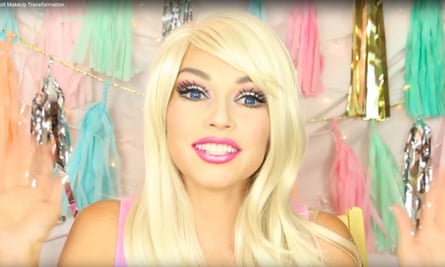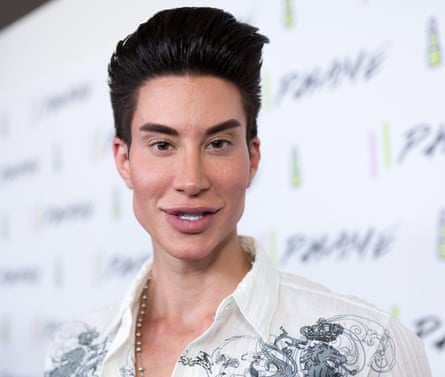There’s a war going on over our bodies. There are unexpected players and uncertain outcomes. As in any war, resources go from one side to the other. As in any war, the ideologies that are involved make the players and the playing field fuzzy: sometimes we see what’s in view and other times it’s just our normality, like gravity, unrecognised but inescapable.
The terrain of the body is changing. New developments – #MeToo, artificial intelligence, epigenetics, egg freezing, selfies, Snapchat dysmorphia, the Kardashians, gut politics, womb rentals, implants, sex dolls – require new thinking. Two trends are butting up against each other: the difficulty of living in the bodies we currently inhabit, with their many predicaments, and the promise of trouble-free, almost body-free existence as we move towards futures constituted by algorithms and synthetic biology.
Add to this the likelihood of a conservative US supreme court trumping the rights of the foetus over the rights of the mother. Now, as certain states have banned abortion and switched the rights in this way, drinking and smoking during pregnancy could invite prosecution. One woman undergoing surgery for breast cancer discovered that she would have her cancer treatment withheld if she were found to be pregnant as the foetus’s rights were deemed paramount.

An understanding of the bodies we inhabit as biological organisms with limits is no longer enough. As late capitalism and social media rewrite the terms of engagement and what it means to be seen and heard, so too the body becomes a battleground. It is being stretched and pressed into new forms of service, display and identity as, at the same moment, we are coached towards a dematerialised existence where almost everything we understand about living – eating, breathing, moving, feeling, relating – will occur in the realm of thought, not in the physical, worldly body.
In South Korea, jawbone shaving is such a common cosmetic surgery procedure that artworks made of glass towers containing the sawn-off bone fragments are displayed. The YouTube star Anastasiya Shpagina from Odessa, who drew 5 million viewers to her instructional video on how to look like Miley Cyrus, and Kandee Johnson from Los Angeles, whose human transformation into a Barbie has had some 33 million viewers, meticulously demonstrate how to change your look. Justin, another YouTuber, has undergone 125 procedures and spent $158,000 to make himself resemble Ken by transforming his torso, face, biceps, triceps and hairline; over 16 million people have seen his video. Closer to home, influencers are finding some commercial value in selling themselves doing beauty, doing bodies. This type of work is unrecognised as beauty labour, but that’s what it is. Not just the sell of the bloggers but the work we are all doing when we make ourselves up. Beauty labour is increasingly deemed essential to girls, women and men. The question is: why? And how has this work, whether it is supplied through surgery, dentistry or visual filters, become desirable?
Bodies are made. They are no longer seen or experienced simply as things to be washed, deodorised, dressed and perfumed before getting on with our day. Bodies now are our ever-malleable calling cards, either erasing or articulating our class, geographic and ethnic backgrounds and gender aspirations. Appearance is crucial and the look, once achieved, has to be endlessly shared and approved through selfies and sexting. Teenage girls sculpt their appearance to garner “likes” and approval, which, sadly, they rarely achieve. Research done for Dove showed that it takes 124 likes to feel OK, but most tend to receive under a fifth of that number, not because they aren’t likable but because everyone is chasing a like, and time is against them.
Living online, seeking recognition online, living through identification and wanting to emulate celebrities such as Kim Kardashian are now commonplace for girls and young women, but again we have to ask: why? Simultaneously there is a craving in the exchange of sexualised body parts in the sexting between teenagers – an updated version of “If you show me yours, I’ll show you mine.” Only mine doesn’t remain yours, but ends up in the phones of your classmates and travels across continents, sometimes to end up as porn fodder for paedophiles and for a more generalised translation of sex into seeing – an erotic that is all the less for being generally fetishised.

Meanwhile, highly profitable industries wage war on us, including the cosmetic, fashion, style, food, diet, health, anti-ageing, wellness, surgical, pharmaceutical and fitness industries, as they promote the body beautiful. Beauty and fashion dominate our department stores – both the real and the virtual. And as they do so there are deadly psychological costs for us as individuals, as well as environmental costs for the planet. There are also social costs for society as appearance ideals eat away at girls, and increasingly boys, and detract from their wellbeing and academic performance. When we learn that one in three girls won’t go for a smear test because they feel so bad about their bodies, we can see how being primed from early on to critically assess themselves makes for pervasively abject bodies.
Just as childhood has become commercialised, so it continues later on. A young woman may take the pill continuously to stop having periods and then take hormone boosters to have her eggs extracted. By the time a woman is in her 50s she has already learned that the menopause is an inconvenience, not the marker of passing from one stage of life into another. Ageing and dying are now being reconceived as infirmities and potentially unnecessary. It won’t be many years before gene therapy cosmetics hit the marketplace, claiming to reverse the disability of looking one’s biological age, while AI helps us retrieve memories and capabilities that have been lost. Meanwhile chemicals are changing bodies. As Penelope Jagessar Chaffer detailed in her 2009 film Toxic Baby, Puerto Rican children living near the chemical plants that manufacture birth control pills are menstruating before they start school. This is a serious finding. A 2010 study published in Pediatrics showed that 15% of American girls now begin puberty by the time they are seven years old. Why?
Bodies are and always have been shaped according to the cultural moment. There has never been a “natural” body: a time when bodies were untainted by cultural practices. How we move our hands as we speak, the way we walk, our table manners, our gait, the food we eat, whether we mark babies at birth via circumcision or later with facial markings: all these tell us that bodies belong to a specific time and place. We are judged physically and our social and economic position has depended on how our bodies are seen and where we are then placed socially and economically. That people now challenge limitations of class, race and, latterly, the biological and gendered designations of male and female is welcomed. What may be less welcome is that globalism, which by its nature exposes the deep inequities of race and class throughout the world, simultaneously offers a story of belonging if one can superficially erase an economic poverty of background by expunging its physical markers and securing the right look, the right kind of body.

But what is happening to bodies in our time? We may well be the last generation to inhabit bodies that are familiar to us. In reproduction we are on the brink of cell manipulation before implantation, gene modifications and different kinds of wombs being used and rented. And after fertilisation, there are surgical interventions, biological replacements, personally tailored pharmaceuticals. The legal and illegal trade in body parts, from hearts to stem cells and kidneys, exposes the commercial nature of our bodies. Our embodiment today stands between a post-industrial moment and a time when bodies will be precision-bioengineered or, as the AI proponents argue, we will be bodyless – a set of electronic algorithms situated in a case, one that now masquerades as a woman with come-hither lips and fluttering eyelashes. This is Hanson Robotics’ Sophia, whose uncanny appearance is similar to the articulated lifesize sex dolls being manufactured in China and the US.
The standardised youthful body we see promoted and which we then endeavour to create individually is not a stable body. It can’t be. Even if one happens to have an approximation of the idealised body, the scrutiny of women’s size, shape and features, with the yearly modifications to the model, means that the girl or woman with a thin body can feel just as insecure. While slim has been a dominant motif since the 1960s, recently tall has been added, as have big breasts and now the big, firm bottom. The slim body is easily felt to be precarious and, all too often, a source of anguish to the individual. The athletic, fit body of the man is increasingly subject to similar strictures to exhibit both strength and now a new sense of needing to be protected, almost wan.
We cannot, of course, yet escape the body. Even as we take on imagined identities online to make virtual connections with others, we cannot live in the material world without bodies. From my own clinical practice, the variety of body difficulties I encounter – anorexia, self-harm, the wish to do away with a body part, eczema, sexual identity confusions, fear of ageing, compulsive exercising – can be seen as the individual’s constant attempt to search for a reliable body and to rid herself or himself of body shame. But body anxiety is as fundamental as emotional anxiety and we need to recognise this. It is essential, especially for therapists, if they wish to be of use to those who consult them.

To address these dilemmas, restoring the body as a reliable place to live from, requires a challenge to our current beliefs and aspirations. The conditions of late modernity are not inevitable. The very tools that have given rise to the narrowing aesthetic could be redeployed to include the wide variety of bodies people actually have: diversity not conformity. In our belief that the body is almost infinitely modifiable, we have become prey to industries and practices that frequently increase our sense of insecurity. We aren’t being creative with our bodies and having fun with them. We are, rather, attempting to create bodies that make us feel better about ourselves.
In addressing the pressures on today’s body, we would also do well to prosecute the diet and wellness industry for false advertising and for failing to meet trading standards. We need to expose suspect practices on the part of the food and pharmaceutical industries, which make food such a painful and emotionally dangerous area for many, and we need to expand the range of body sizes included in visual culture and fashion design so that they become more reflective of bodies as they actually exist.
We need to be vigilant about our rights to have a body. Between a US supreme court that may institute federal anti-abortion legislation and the transhumanist argument that those with diseased or troubled bodies can be cured (if they have the money) by new technology or psychopharmacology, bodies are under threat. But for as long as we are embodied, I end with a plea for us to rethink the body in such a way that we can both take it for granted and enjoy it.
Our struggle is to recorporealise our bodies so that they become a place we live from rather than an aspiration always needing to be achieved. We urgently need to curtail the commercial exploitation of the body and the diminution of body variety, so that we and our children can enjoy our bodies, our appetites, our physicality and our sexuality. Our bodies should not be turned into sites of labour and commercially driven production. We need to be able to experience our diverse bodies – the varied ways we decorate and move them – as a source of taken-for-granted pleasure and celebration. We need bodies sufficiently stable to allow us moments of bliss and adventure when, secure in the knowledge that they exist, we can then take leave of them.
